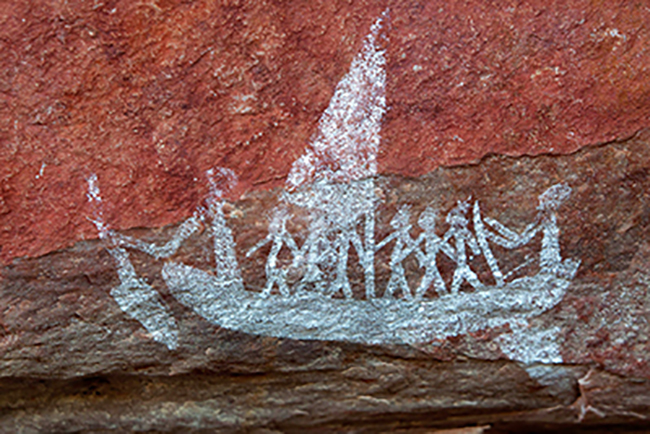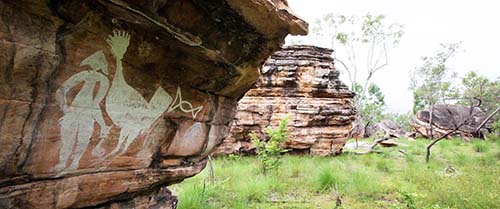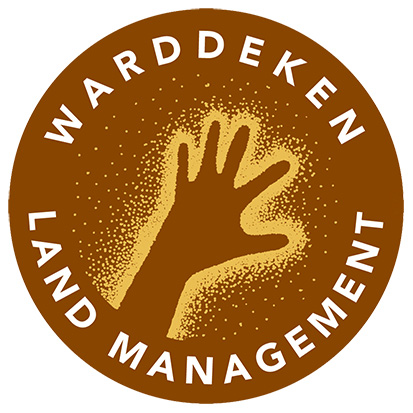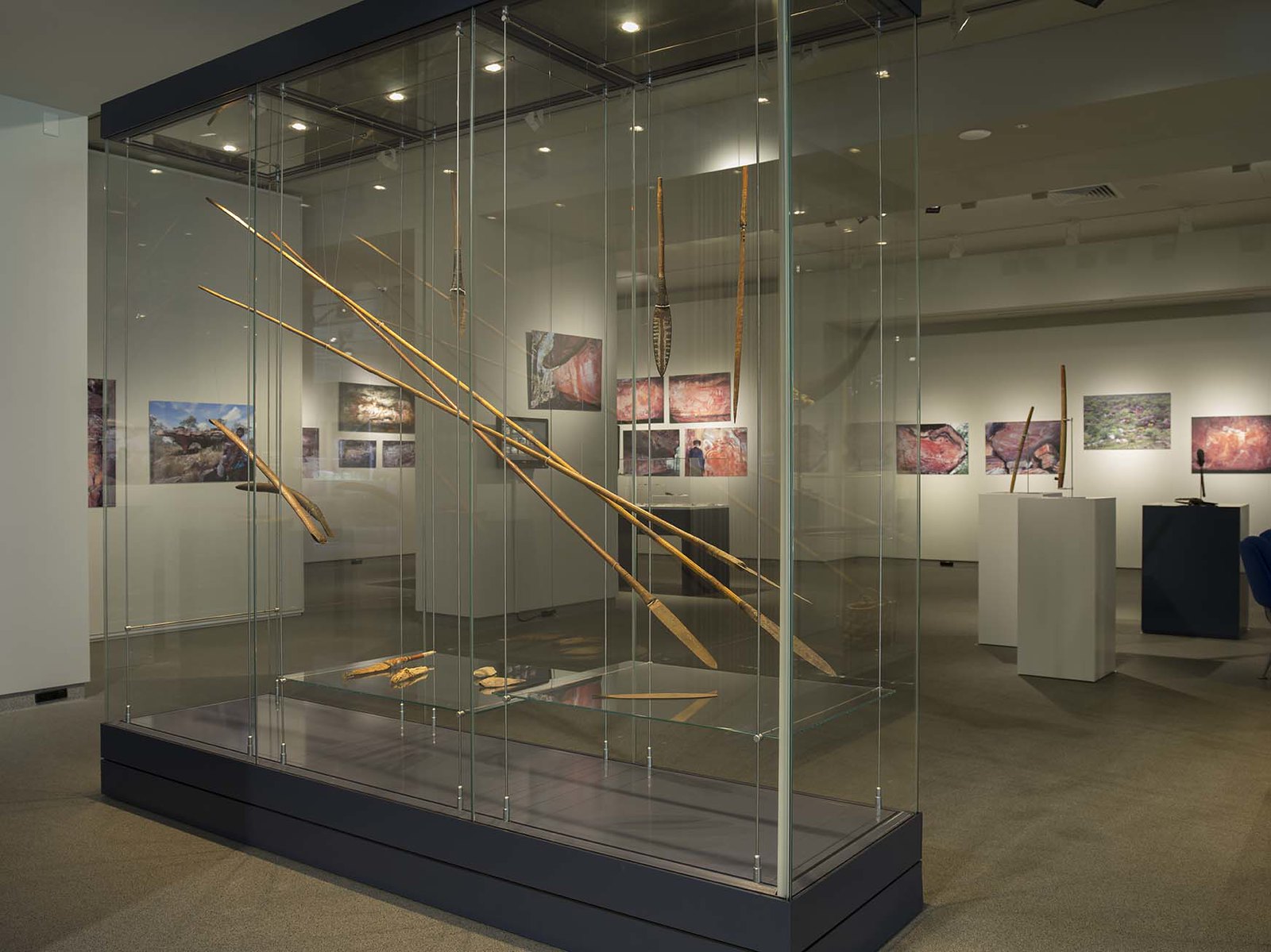An archive of threatened Aboriginal reportage from the Western Arnhem Land Plateau
22 February 2016 - 7 August 2016
Curated by Peter Cooke for Warddeken Land Management with photos by David Hancock
Fragile First Impressions reveals a remarkable body of Indigenous reportage of a north Australian Frontier. From an image of a first encounter with the explorer Leichhardt in 1845 a large visual record of contact is being rediscovered, recorded and conserved by the Aboriginal people of the plateau — or Nawarddeken as they call themselves.
Complex over-layered images across sandstone galleries reveal among other things man-sized chickens, guns, policemen and buffalo. Complementing this imagery are objects from the UQ Anthropology Museum’s collection and some loans from private collectors.
These things demonstrate the incorporation of novel materials into Aboriginal social life – three painted smoking pipes with cartridge shells as the pipe bowl for example. There is also a real buffalo skull.
Terrah Guymala, a senior Indigenous land manager observes of the rock paintings, “now we have only the pictures. The voices are gone and understanding the stories behind them is a puzzle — like detective work.” One of these lost voices is that of esteemed artist and elder Bardayal (Lofty) Nadjamerrek (1926-2009) who led a return to country of the Warddeken diaspora and who was passionate about sharing his knowledge of his people’s contact history. Amongst the objects in the exhibition is a stone palette on which Bardayal prepared ochre pigments. Kim Mackenzie’s film made with Bardayal, Fragments of the Owl’s Egg, is also showing in the gallery. Tracing the fragility of memory, the film follows Bardayal and his friends in their search for Wilark Mukmuk, a magnificent rock art site located somewhere on the West Arnhem Land Plateau.

The plateau country was rugged, inaccessible and unsuited to pastoralism or agriculture and so frontier interactions remained at a distance; on lowlands worked by buffalo hunters, in other areas of small-scale tin mining and later with the establishment of a mission at Oenpelli - what is now Kunbarlanja.
Attracted by exotic goods and exciting experiences younger people from the plateau went out to meet the frontier returning home with stories to tell ‘…they would be asked by their children to paint illustrations of stories or animals. The children would say ‘paint it for me!” Bardayal recalled. They also brought back textiles, fish-hooks, iron for spear points and, importantly, tobacco.
These rock art images, recorded by photojournalist David Hancock for the exhibition, show that Aboriginal artists encountering horses for the first time on the Western Arnhem Land Plateau drew horses that resemble kangaroos. This parallels the experience of early colonial artists whose first attempts at depicting Australian fauna was influenced by their own cultural experience of European animals.
Preparing the exhibition has involved connecting Aboriginal oral histories (like those provided by Bardayal) with written reports from non-Aboriginal sources and material from an archaeological site on the Alligator River floodplains.

In some cases a remarkable accurate connection has been made. In 1883 the first European party to cross the plateau from north to south, led by the surveyor David Lindsay spelled their horses for four days and cast away a fishing net and saddle bags, Lindsay recording in his journal the event and the location of his camp. Only 10 years ago a gallery with clear depictions of the cast off material and Europeans, horses and guns was found only a few kilometres from David Lindsay’s camp, a rare chance to specifically date a rock art image: in this case to October 1883.
Excavations from Minjnymirnjdawabu, a site at Wulk Lagoon in Manilagarr clan country, are also in the show. The archaeology of this large sandstone rockshelter shows at least one thousand years of people living there. The upper layers of the excavation record the arrival of glass beads from Macassan traders and European contact materials such as glass, ceramics, buttons and bullets. Amongst these layers, a 1972 two cent piece is a reminder that while the site has a rich history, it remains a living place.
The exhibition includes a second documentary film by filmmaker Kim McKenzie, Something of the Times that reconstructs life in Northern Territory buffalo camps in the 1930s, offering insight into relationships at a point of cultural intersection.
View full photo gallery on Flickr: Fragile First Impressions
Acknowledgements
Curation: Peter Cooke for Wardekken Land Management
Photographs: David Hancock
Films: Something of the Times and Fragments of the Owl’s Egg: Kim McKenzie
Archaeological material and accompanying essay: Daryl Wesley and Manilagarr Traditional Owners
Maps: Will Smith
Director of curation: Diana Young
Project co-ordination: Jane Willcock
Installation: Kiri Chan, Camella Hardjo, Sarah Webb, Jane Willcock, Kate Stanway, Diana Young
With thanks to Murray Garde, Jon Altman, Chips Mackinolty Dean Yibarbak and Norrie Martin-Redford
Peter Cooke would like to dedicate this exhibition to the memory of Bardayal (Lofty) Nadjamerrek AO, Kim McKenzie, George Chaloupka OAM and Jimmy Kalariya

